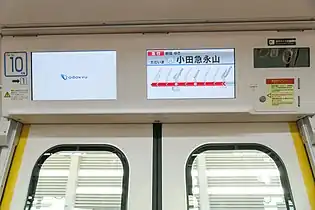| Odakyu 5000 series | |
|---|---|
 A 5000 series train in November 2021 | |
| In service | March 2020 – Present |
| Manufacturer | Kawasaki, J-TREC, Nippon Sharyo |
| Constructed | 2019– |
| Entered service | 26 March 2020 |
| Number under construction | 30 vehicles (3 sets) |
| Number built | 100 vehicles (10 sets) |
| Number in service | 100 vehicles (10 sets) |
| Formation | 10 cars per set |
| Capacity | 144 (end cars)[1] 155 (intermediate cars)[1] |
| Operators | Odakyu Electric Railway |
| Lines served | |
| Specifications | |
| Car length | 20.4 m (66 ft 11 in) (end cars)[2] 20 m (65 ft 7 in) (intermediate cars)[2] |
| Width | 2.9 m (9 ft 6 in)[2] |
| Doors | 4 pairs per side |
| Traction system | Mitsubishi Electric MAP-194-15V330 SiC-MOSFET–VVVF inverter PG sensorless vector control |
| Traction motors | Mitsubishi MB-5157-A2 190 kW (250 hp) totally enclosed fan-cooled 3-phase AC induction motor |
| Acceleration | 0.92 m/s2 (2.1 mph/s) |
| Deceleration | 1.1 m/s2 (2.5 mph/s) (service) 1.3 m/s2 (2.9 mph/s) (emergency) |
| Electric system(s) | 1,500 V DC overhead catenary |
| Current collector(s) | Pantograph |
| UIC classification | 2′2′+Bo′Bo′+2′2′+Bo′Bo′+Bo′Bo′+2′2′+2′2′+Bo′Bo′+Bo′Bo′+2′2′ |
| Safety system(s) | D-ATS-P |
| Track gauge | 1,067 mm (3 ft 6 in) |
The Odakyu 5000 series (小田急5000形, Odakyū 5000-gata) is a commuter electric multiple unit (EMU) train type operated by the private railway operator Odakyu Electric Railway in Japan since 26 March 2020.[3]
Formation
The trains are formed as follows, with ten cars per set.[2]
| Car No. | 1 | 2 | 3 | 4 | 5 | 6 | 7 | 8 | 9 | 10 |
|---|---|---|---|---|---|---|---|---|---|---|
| Designation | Tc1 | M1 | M2 | T1 | T2 | M3 | M4 | T3 | M5 | Tc2 |
| Numbering | KuHa 5050 | DeHa 5000 | DeHa 5100 | SaHa 5150 | SaHa 5250 | DeHa 5200 | DeHa 5300 | DeHa 5350 | DeHa 5400 | KuHa 5450 |
| Capacity (total)[1] | 144 | 155 | 155 | 155 | 155 | 155 | 155 | 155 | 155 | 144 |
All motor cars except M5 have one single-arm pantograph.
Interior
Seating accommodation consists of longitudinal seating.[1] The interior also features a warm color palette, wood flooring, air purifiers, LED lighting, security cameras, and wheelchair spaces.[4]
 General interior view
General interior view Priority seating
Priority seating Wheelchair space
Wheelchair space LCD passenger information display
LCD passenger information display
Technical specifications
The trains use SiC–VVVF technology.[1] The bogies are built by Nippon Sharyo.[4]
History
Odakyu announced initial details of the trains on 26 April 2019.[5] Five sets were built by Kawasaki Heavy Industries, two were built by Japan Transport Engineering Company, and three were built by Nippon Sharyo.[6] The first train was revealed to the press on 11 November 2019.[6] The train entered service on 26 March 2020.
Another batch consisting of three trainsets will be constructed according to Odakyu Railway's 2022 capital investiment plan.[7] The new trainsets are set to replace three older Odakyu 1000 series trainsets.
References
- 1 2 3 4 Fukuoka, Makoto (11 November 2019). "小田急電鉄の新しい通勤車両「5000形」がお披露目" [Odakyu Electric's new commuter vehicle "5000 series" is unveiled]. Tetsudo Shimbun (in Japanese). Archived from the original on 16 November 2019. Retrieved 18 November 2019.
- ↑ Japan Railfan Staff (7 February 2020). "Odakyu 5000 Series commences commercial operation on March 26". Japan Railfan (in Japanese). Koyusha Co Ltd. Retrieved 26 March 2020.
- 1 2 "小田急12年ぶりの新型通勤車両、「5000形」を見る" [Odakyu's first new commuter vehicle in 12 years, see the "5000 series"]. tetsudo.com (in Japanese). ASAHI INTERACTIVE, Inc. 14 November 2019. Archived from the original on 16 November 2019. Retrieved 18 November 2019.
- ↑ "小田急、新型の5000形電車を2019年度に導入 車内の「広さ」追求" [Odakyu introduces new 5000 series train in 2019]. trafficnews.jp (in Japanese). Mediavague Co., ltd. 26 April 2019. Archived from the original on 10 November 2019. Retrieved 18 November 2019.
- 1 2 "小田急,5000形を報道陣に公開" [Odakyu releases 5000 series to the press]. Japan Railfan Magazine Online (in Japanese). Japan: Koyusha Co., Ltd. 12 November 2019. Archived from the original on 18 November 2019. Retrieved 18 November 2019.
- ↑ "2022年度 鉄道事業設備投資計画" [2022 Railway Business Capital Investment Plan] (PDF). Odakyu Railway Online (in Japanese). 28 April 2022. Retrieved 29 April 2022.
External links
- Odakyu news release (in Japanese)
